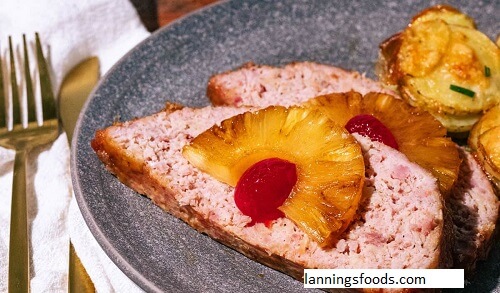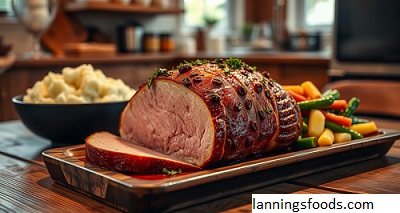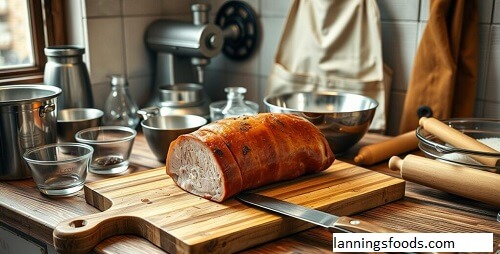Ham Loaf Glaze Recipe from Weaver’s: The Best Finishing Touch Ever
This dish ham loaf is one of the most comforting fare of middle American cuisine. A Ham oaf is made from ground ham, ground pork, or ground beef, and then baked. What takes it over the top is the glaze. The glaze helps this ham find its perfect complement in terms of flavor which balances the richness with sweet, tangy, and savory flavors. Among countless ham glazes out in the market, Weaver’s Ham Glaze was unique due to its ingredients balance which also created a glossy finish for the loaf and enhanced the depth of its flavors.

This article will look into the recipe for Weaver’s Ham Glaze, discuss its origins, and answer a few frequently asked questions about its making and use.
What Is Weaver’s Ham Loaf Glaze?
Weaver’s Ham Glaze is a very simple recipe yet full of flavor using only a few must ingredients, such as brown sugar, mustard, vinegar, and seasonings. Those ingredients make a glaze caramelized atop the ham loaf as it bakes, presenting a delightful contrast to the ham savory flavors. The ham gets a pretty, glistening finish along with its sweet-tangy taste that makes it irresistibly delicious.
Ingredients for Weaver’s Ham Loaf Glaze:
Here is what you’ll need to make Weaver’s Ham Loaf Glaze:
- 1 cup brown sugar: Brown sugar provides the sweetness that balances the tangy and savory flavors in the glaze.
- 1/2 cup apple cider vinegar: This adds the acidity and the tang needed to cut into the richness of the ham and complement the sweetness of the sugar.
- 1/4 cup Dijon mustard: The Dijon mustard gives it a little kick, and adds depth of flavor to the glaze. This is milder than yellow mustard but still bites with a tangy pungency.
- 1 tablespoon Worcestershire sauce: It adds to the savory umami-type flavor that will give some depth and complexity to the glaze.
- 1/4 teaspoon ground cloves: Warm aromatic with small amounts adding depth to the overall flavor of the glaze.
- 1/4 teaspoon salt: A pinch of salt brings all flavors out in the glaze, balancing everything.
- teaspoon black pepper: A fresh grind of black pepper will add the undertone of heat and spice to balance the sweetness and tang.
Weaver’s Ham Loaf Glaze Instructions:
Put all the ingredients in a medium saucepan with brown sugar, apple cider vinegar, Dijon mustard, Worcestershire sauce, ground cloves, salt, and black pepper. Stir well.
- Heat it: Place the saucepan on medium heat and bring to a simmer. You might have to stir occasionally to let some of the brown sugar dissolve into the liquid and allow the flavors to meld together.
- Simmer and thicken: Allow the glaze to simmer for about 5-7 minutes. At this time, it should get a bit thicker and the flavors have sunk into the glaze. Stir frequently so that it won’t burn at the bottom of the pan.
- Check the consistency: It must now become a bit thick, yet liquid enough to pour. If too thick, you can add a small amount of water and loosen it to your desired consistency.
- Apply a glaze over the ham loaf: During the middle part of the baking time for the ham, brush a thick layer of the glaze over the top of the. Continue baking, glazing every 15-20 minutes till the is fully cooked and the glaze caramelizes to golden brown.
- Serve and enjoy: When the ham is done, remove it from the oven and let it rest for just a few minutes before slicing. The glaze will work perfectly to produce a crispy crust on top of the ham loaf, which bursts in flavor as you take each bite.
Tips for Making Weaver’s Ham Loaf Glaze:
- Add a bit of sweetness to it: I like it a little sweeter so I add a bit of brown sugar; if it’s too sharp, a bit more vinegar does the trick. Taste it as you go to balance it out.
- Different kinds of mustards are to be used: When it comes to gentle heat, Dijon mustard must take the prize; however, you can also use the other varieties of mustard which are yellow mustard and whole grain mustard to give different flavors to your glaze.
- Double the recipe: It is quite alright if you like having many glazes. Feel free to double the recipe if you wish. You can store it in the fridge if you have excess glaze left.
- Make ahead: The glaze can be prepared ahead of time and kept in an airtight container in the refrigerator for as long as a week. Just reheat it before using it on your ham.
What Makes Weaver’s Ham Loaf Glaze Special?

This glaze from Weaver’s Ham is unique in its sweet, tangy, and savory balance. The brown sugar is almost perfectly sweet; however, the apple cider vinegar’s brightness and its tanginess balance it out completely. Finally, the layers of complexity added by Dijon mustard and Worcestershire sauce are much more than a simple glaze; ground cloves and black pepper add subtle warmth and spice to the whole dish.
Another reason why Weaver’s Ham Glaze is popular is because it is versatile. It is perfect not just for ham loaf but also as a glaze for other meatloaf, roasted pork, or even grilled chicken. It is just a simple glaze, but it makes ordinary meats special.
How to Serve Weaver’s Ham Loaf with the Glaze:
- We serve Weaver’s Ham as a main dish. It accompanies any side dishes, whether mashed potatoes or roasted vegetables, green beans, or a salad which should be crisp. A real showpiece is a sweet-tart glaze; therefore, simple sides to balance the richness of the meat are proper in this case.
- Ham loaf can be served hot right from the oven or cold as leftovers. The glaze keeps the moist when reheating and adds an extra zest and texture.
Frequently Asked Questions (FAQs):
1. Can I use another type of vinegar in the glaze?
You can simply substitute with other types of vinegar like white wine, red wine or even balsamic. However, because the flavor of apple cider vinegar is milder yet slightly fruity, that is probably why it is such a commonly used vinegar for Weaver’s Ham Glaze. Using another vinegar may alter the taste so do try before adding more sweetness and adjusting acidity balance.
2. Is it possible to prepare the glaze ahead of time?
Absolutely! Better yet, you can prepare the glaze ahead of time a day ahead. You’ll save yourself an incredible amount of time getting the ham loaf ready. Store it in the refrigerator in an airtight container for up to one week. Simply reheat the glaze gently in a saucepan over low heat before brushing it on the ham.
3. Is the glaze suitable for another type of meat?
Of course, the glaze goes with almost any meat besides steak. For instance, with meatloaf, chops of pork can be even spread on a roasted chicken. Anything can work for those who have such a profile to balance different savory flavors on it. Feel free.
4. Can I make it either sweeter or less acidic?
Absolutely! If you prefer the glaze a little sweeter, you can add some more brown sugar. If you prefer it even a bit sourer, add a bit more vinegar. Taste and adjust the seasonings to your preference.
5. Why does the glaze sometimes separate or get too thick?
If your glaze is too thick, that’s a sure indication that the sugar cooked down too far. So thin it out by adding just a little bit of water or a little more vinegar. If your glaze separated, then maybe the mustard or Worcestershire sauce didn’t emulsify properly. Whisk this mixture quickly, and you will resolve the situation.
Conclusion:

Ham Loaf Glaze by Weaver’s: An alternative ham glaze that makes a tasty and simple recipe to elevate ham to new heights. The perfect mixture of sweet, tangy, and savory profiles combined with the richness of the ham to offer an irresistible finish. Be it a holiday meal or dinner throughout the week, the salty glaze is sure to strike a chord with your family and guests. Reading through this article should help guide you through making a ham loaf that’s sweet, well-glazed, and full of flavor as long as you just stick to the instructions and tips given.